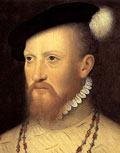The son of Sir John Seymour, Edward Seymour served on various military and diplomatic missions for King Henry VIII. After the marriage of his sister, Jane Seymour, to the king (30 May 1536), Edward was created viscount (5 Jun 1536). Upon her death (14 Oct 1537), he was made Earl of Hertford (18 Oct 1537). In 1542 he was appointed Lord High Admiral, a post he soon relinquished. He served on the military campaigns in Scotland (1544) and Boulogne (1545). As uncle of young Prince Edward (later Edward VI), Seymour was appointed one of the executors of Henry VIII's will. After the death of Henry VIII, Seymour was nominated by the executors (31 Jan 1547) and approved by the king (1 Feb 1547) as "Protector of all the realms and dominions of the King's Majesty that now is, and of the Governor of his most royal person." He was also given the posts of Treasurer of the Exchequer (10 Feb 1547) and Earl Marshal of England (17 Feb 1547), and created Duke of Somerset (16 Feb 1547). The Protector and the King's Privy Council received the full authority from Edward VI on 13 Mar 1547, but Somerset surpassed the restrictions of the Council and wielded almost royal authority in effecting major Protestant reforms. He was aided by Archbishop Thomas Cranmer, and their efforts resulted in the adoption of the first Book of Common Prayer (1549). Trying to enforce a marriage of Edward VI and Mary Queen of Scots, Somerset invaded Scotland and defeated the Scots at Pinkie (10 Sep 1547). In 1549 Somerset crushed the influence and beheaded his brother, Thomas Seymour, who intended to marry Princess Elizabeth (later Queen Elizabeth I). The Earls of Warwick and Southampton took advantage of this cruel execution and popular uprisings in the West Country and Norfolk to deprive Somerset of the protectorate. The Privy Council proclaimed him a traitor (8 Oct 1549) and raised troops against him. Somerset was arrested as he was fleeing Windsor Castle on 10 Oct 1549. Four days later (14 Oct 1549) Somerset was imprisoned in the Tower of London, but he was released in 1550. A revival of his influence provided Warwick with a pretext to arrest him again (1551). Somerset was convicted on a charge of felony and beheaded on 22 Jan 1552. Biography source: [3][4]
|

